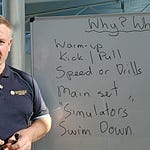By Wayne Goldsmith
By Wayne Goldsmith
Three Key Concepts
Traditional 1-1-1-1 periodization (1 week, 1 month, 1 quarter, 1 year) is calendar convenience, not biological reality
Expecting all swimmers to adapt to training loads by Sunday night for Monday morning progression is coaching insanity
Bold coaches create periodization around adaptation timelines, not calendar constraints
We've brainwashed an entire generation of swimming coaches into believing that periodization must follow the calendar. One week microcycles. One month macrocycles. One quarter phases. One year seasons. The sacred 1-1-1-1 model that every coaching course teaches as gospel.
Here's the problem: human adaptation doesn't follow a calendar.
Your swimmers don't magically recover and adapt to training loads because it's Sunday night and you need them ready for a new training phase on Monday morning. Biology doesn't care about your neat weekly schedule or monthly planning charts.
Think about what we're actually expecting here. You've got swimmers with different birth dates, ages, genetics, recovery rates, nutrition habits, sleep patterns, stress levels, and training backgrounds. Yet we teach coaches that ALL of these athletes will adapt to the same training stimulus in exactly seven days, allowing for seamless progression to the next phase.
This is dumb in the extreme.
Some swimmers need ten days to adapt to a training block. Others might need fourteen. Some might be ready in five. Your 13-year-old developmental swimmer and your 17-year-old senior don't operate on the same biological timeline just because they're both in Tuesday's practice.
Here's what bold coaches do: they throw out the calendar and follow the adaptation.
Why not ten-day microcycles? Why not thirteen-session cycles that take as long as they take to create the changes you're seeking? Why not base your periodization on how your swimmers are actually responding rather than what date appears on your planning calendar?
I've worked with coaches who run nine-day cycles, others who use fifteen-session blocks regardless of how many calendar days that requires. They watch their swimmers, assess their adaptation and progress when biology says they're ready—not when the calendar demands it.
Stop forcing your swimmers to fit into arbitrary time constraints. Start designing periodization around the reality of human adaptation.
Summary: True periodization follows biological adaptation timelines, not calendar convenience. Bold coaches create training cycles based on how swimmers actually respond to training loads.
Three Practical Exercises:
Adaptation Assessment: Instead of automatic weekly progressions, evaluate swimmer readiness through stroke mechanics, energy levels, and training response before advancing phases.
Flexible Cycles: Experiment with 9, 10, or 13-day microcycles based on training response rather than calendar weeks—track adaptation quality over time adherence.
Session-Based Planning: Design training blocks around specific session counts (e.g., 15 sessions) that progress when adaptation occurs, regardless of calendar timeframe.
VIDEOS RECORDED AT BEAUTIFUL EVANS HEAD AQUATIC CENTRE, NSW, AUSTRALIA with the kind courtesy of RICHMOND VALLEY AQUATICS.
https://richmondvalleyaquatics.com.au/
Copyright Wayne Goldsmith. All Rights Reserved.













Share this post